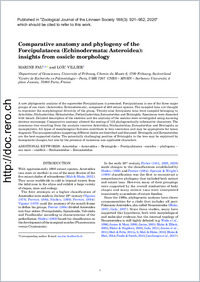Comparative anatomy and phylogeny of the Forcipulatacea (Echinodermata: Asteroidea): insights from ossicle morphology
- Fau, Marine Department of Geosciences, University of Fribourg, Switzerland
- Villier, Loïc Centre de Recherche en Paléontologie Paris, UMR 7207 CNRS, Paris, France
-
27.06.2020
Published in:
- Zoological Journal of the Linnean Society. - 2020, vol. 189, no. 3, p. 921–952
English
A new phylogenetic analysis of the superorder Forcipulatacea is presented. Forcipulatacea is one of the three major groups of sea stars (Asteroidea: Echinodermata), composed of 400 extant species. The sampled taxa are thought to represent the morphological diversity of the group. Twenty-nine forcipulate taxa were sampled belonging to Asteriidae, Stichasteridae, Heliasteridae, Pedicellasteridae, Zoroasteridae and Brisingida. Specimens were dissected with bleach. Detailed description of the skeleton and the anatomy of the ossicles were investigated using scanning electron microscopy. Comparative anatomy allowed the scoring of 115 phylogenetically informative characters. The consensus tree resulting from the analysis recovers Asteriidae, Stichasteridae, Zoroasteridae and Brisingida as monophyletic. All types of morphological features contribute to tree resolution and may be appropriate for taxon diagnosis. The synapomorphies supporting different clades are described and discussed. Brisingida and Zoroasteridae are the best- supported clades. The potentially challenging position of Brisingida in the tree may be explained by homoplastic changes, but also by the presence of numerous non- applicable characters.
- Faculty
- Faculté des sciences et de médecine
- Department
- Département de Géosciences
- Language
-
- English
- Classification
- Palaeontology
- License
-
License undefined
- Identifiers
-
- RERO DOC 329424
- DOI 10.1093/zoolinnean/zlz127
- Persistent URL
- https://folia.unifr.ch/unifr/documents/308977
Statistics
Document views: 123
File downloads:
- pdf: 372
